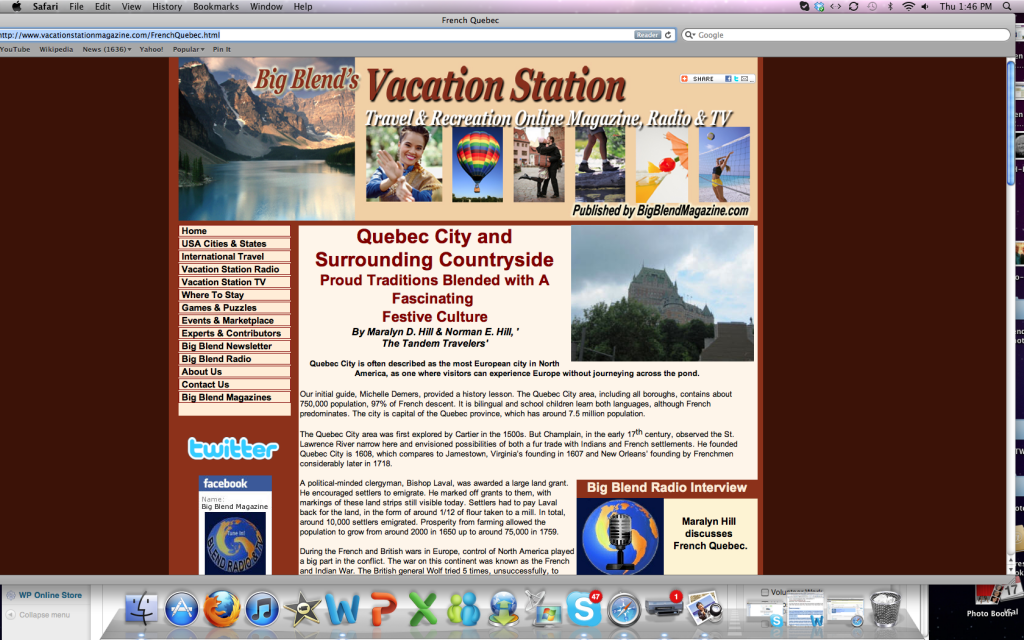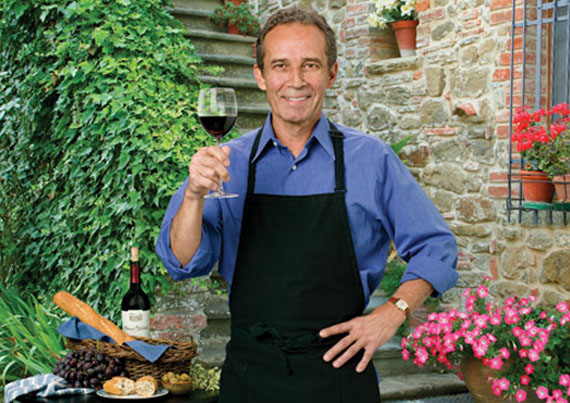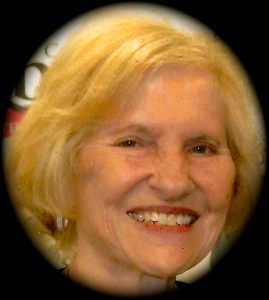http://www.vacationstationmagazine.com/FrenchQuebec.html Big Blend’s Vacation station 1.2 to 1.5 million
http://www.vacationstationmagazine.com/MHill9-20-2010.mp3 Radio Show 25,000 to 75,000 over 3 months
French Quebec PDF
YouTube http://youtu.be/Z-sQpQWbD9s
Screen Shot
.
.
.
.
.
.
.
.
.
.
.
.
.
.
Quebec City and Surrounding Countryside
Proud Traditions Blended with A Fascinating
Festive Culture
By Maralyn D. Hill & Norman E. Hill, ‘
The Tandem Travelers’
.
Quebec City is often described as the most European city in North America, as one where visitors can experience Europe without journeying across the pond.
Our initial guide, Michelle Demers, provided a history lesson. The Quebec City area, including all boroughs, contains about 750,000 population, 97% of French descent. It is bilingual and school children learn both languages, although French predominates. The city is capital of the Quebec province, which has around 7.5 million population.
The Quebec City area was first explored by Cartier in the 1500s. But Champlain, in the early 17th century, observed the St. Lawrence River narrow here and envisioned possibilities of both a fur trade with Indians and French settlements. He founded Quebec City is 1608, which compares to Jamestown, Virginia’s founding in 1607 and New Orleans’ founding by Frenchmen considerably later in 1718.
A political-
During the French and British wars in Europe, control of North America played a big part in the conflict. The war on this continent was known as the French and Indian War. The British general Wolf tried 5 times, unsuccessfully, to take the fortified Quebec City with its very tight hilltop location. He burned local farms and one mill, but could not budge the entrenched French. Finally, a scout spotted women washing clothes in the lowlands river. They found a very small path, going up the steep hillside. At night, Wolf led his men up the steep path. The French general, Montcalm, believing the heights were impregnable, held very weak defenses here.
Wolf’s force reached the Plains of Abraham at the summit. Next morning, when the French saw the British, a brief battle ensued. Montcalm’s troops were routed, and both generals were killed. The legend is they both died heroes. While dying, Wolf asked, “Did we win?” For Montcalm who died the next day, he expressed relieve that he would not have to live under British rule.
As a result, all of French North America east of the Mississippi was ceded to Britain. French settlements in New Orleans, which included a vast territory west of the Mississippi, were ceded to Spain.
Wolf’s improbable victory was a bitter defeat for France, which no doubt still rankles in the minds of some Quebecois. France regained some military revenge by providing vital help to the colonies during the American Revolution.
Initially, the British tried to stamp out the Catholic religion, despite its tolerance in Britain itself. However, the new rulers were cognizant of the growing unrest in American colonies to the south. As a result, the Quebec Act was passed by Parliament in 1774. It provided complete tolerance for Catholicism and restored French civil law in Quebec.
Our own understanding is that the Colonials under Arnold came close to conquering Quebec shortly after. But the French clergy were comfortable with their new arrangements with British authorities. Also, they were apparently alarmed by widespread irreligious attitudes among the colonials. This was part of the Enlightenment approach popular in the thirteen colonies. Some of them considered themselves Deists.
Because of this concern of the clergy and others, invading colonials were deeply disappointed to find that the expected anti-
Today, the historical significance of the French colonial era is perpetuated in the New France Festival every August. This event is now in its 14th year.
One key part of this festival is the International Fireworks competition. It is held in Montmorency Falls Park. Despite rain, severe at times, fireworks proceedings were on schedule. Rather than mere fireworks by themselves, musical accompaniments, representing different world areas, are part of each skyward display. Precise synchronization between recorded music and fireworks is essential and it came off without a hitch.
Participants are encouraged to wear costumes of the sort worn by people who lived and worked in the 17th century. We were pleased to wear French colonial costumes fitted for us, since it gave us the chance not only to observe festivities but to be emotionally absorbed in them. We were one of the 65% of participants who were tourists.
Interestingly, wenches and members of lower classes wore garb that was easier to fit. For some reason, we were provided with gentry garb. However, this required some assistance for the women to have the back laced. One member of our group asked to be a wench, which resulted in easy dressing for her.
We were advised to wear comfortable shoes and were happy we did. Quebecers walk a lot and the city has more hills than San Francisco. We know, as we walked many. One evening we walked to meet our host, Patrick Lemaire with SAQ New France Festival for dinner at Les Voûtes du Cavour located in an 18th century house in the centre of Place Royale, the birth pace of Québec City.
Vendors provided varieties of food and desserts for attendees. Vocalists sang many French folk songs, to which participants often joined in. We joined those in soldier costumes in a parade march through many of the old city streets.Some enthusiastic young people follow through on a desire to be married as part of the festival. Outside of the small local church, Notre Dame De Victories, we witnessed this year’s wedding ceremony.
The New France Festival is but one of a long list of Quebec City festivals held throughout the year even in winter with its winter carnival and ice hotel.
We were fortunate to start our trip staying at the Hôtel Loews Le Concorde outside the wall of Old Quebec City. The area that is alive with the two largest nightclubs and an abundance of sidewalk cafés. Looking out our window at night, we could see the area come alive and yet the beauty of the old city in the background. We enjoyed our breakfasts and a dinner at the hotel’s revolving panoramic restaurant, L’Astral. It was delightful seeing it day and night.
After four nights, we moved to the iconic Fairmont Le Château Frontenac for the New France Festival celebration. We enjoyed our breakfasts at the Château and our final formal dinner in New France dress at the hotel’s restaurant Le Champlain.
Arriving before the festival gave us time to enjoy many of the aspects of this wonderful destination including a special performance created exclusively for Québec City by Cirque du Soleil®. They originally started there. We walked and explored, drove and discovered this vibrant area. However, participating in the New France Festival was a first for us and fun.
All in all, our trip to Quebec City and participation in the New France Festival gave us a new appreciation of the colorful history of the region and admiration for its people.








Great article Maralyn! Thanks so much. The 2012 SAQ New France Festival is about to kick off August 1-5, 2012.
Festival goers should get their Medallion For access to all venues and activities as it is the official SAQ New France festival pass. http://www.nouvellefrance.qc.ca/en/about-the-saq-new-france-festival/about.html
Thank you. We think that is such a wonderful festival, I wanted to re-post the the article to remind people it is coming up August 1-5. We had so much fun and learned a great deal about the time period. Dressing up in costumes and being in the parade will be something we will always remember in addition to everything else we did. Quebec City is lucky as they have so much to offer from dining to cultural heritage.